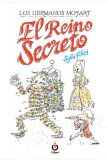New Spanish Books: The online guide of titles from Spanish publishers and literary agents with rights for translation in the UK. To consult titles available in other markets please click on the above links.
El Reino Secreto (de los hermanos Mozart)

Thirteen-year-old Narnel Mozart is the older sister of the brilliant composer Wolfgang Amadeus Mozart. Like any boy his age, he loves playing and mischief, and what he finds most difficult to understand is adults. He likes parties… but not the ones he's invited to, in courts and palaces. There, people look at him as if he's weird. His sister is the one who knows him best, and when she feels Wolfli is going to explode with so many responsibilities and obligations, she creates a fantasy world for him: the magic kingdom of Rücken, where they both find a niche. Basing her story on the diaries of Maria Anna Mozart, Sofía Rhei opens a window onto the real life of the Mozart siblings, mixing the complex day to day lives of the two musicians with the marvellous fantasy of The Magic Flute. The reader must decide at what moment reality overcomes fiction…
Sofía Rhei’s magical children’s novel opens on 27th September 1764, in a house in London, where Nannerl and Wolfi (Maria Anna and Wolfgang) Mozart are staying while touring the country, giving concerts in the mansions of the nobility.
Life for the Mozart siblings is not always easy; their father forces them practice constantly and Wolfi, then almost nine, finds the constraints of his life difficult to bear. Nannerl, his thirteen-year-old sister, whose diary entries we are reading, cannot always understand why her father does not seem to appreciate her talents and tends to blame her when Wolfi disobeys orders and sneaks out of the house to listen to the birds.
While one would imagine from the age of the main characters that this novel is aimed at children between ten and thirteen, Sofía Rhei has created a story capable of capturing the attention of readers of all ages. The prose style is clear, concise, with a vocabulary accessible to younger readers, while never talking down to them. Although set in the 18th century, the text makes no attempt either to use archaisms, or overtly modernise the language.
Written as a series of first-person diary entries, the novel not only explores the childhoods of Mozart and his elder sister, but also addresses the deeper issues which children of any era must address. Among the most important of these is the state of the young Mozart’s mental health: is he, as seems to be rumoured, mad? Or could his difficulty in relating to the emotions of others be a sign of autism?
A number of other books have been produced on the theme of The Magic Flute (mostly in picture-book format), but where this novel differs is in the way it imaginatively transfers elements of the opera into the children’s lives, almost suggesting the basis for the writing of the opera itself. González’s brilliant illustrations add a further level of depth to the narrative: reminiscent of Quentin Blake, they are sometimes whimsical, but also capable of expressing the darker elements of the plot. In addition, they include snatches of the melodies referred to in the text, which any child studying music could relate to.
I strongly feel that this book, with sensitive translation, would find a home in the English-language market, and would moreover suggest that, as they contain no textual elements, González’s illustrations could successfully used in this context. I feel it is a book which, in addition to its pedagogic value, will cross age boundaries and delight readers of any generation, both in the reading or the telling.
From the reader´s report by Christina MacSweeney
